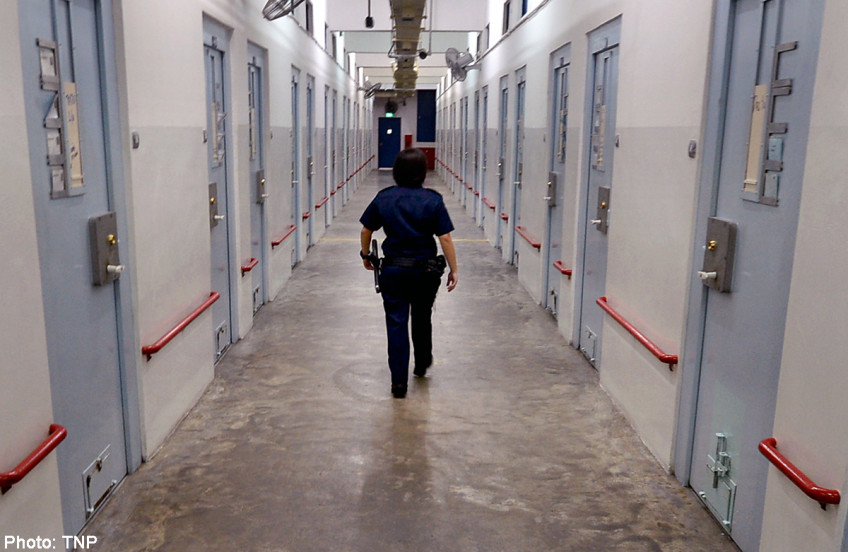Changi Women's Prison: Not a place you want to return to

Do not drop your pen cap.
That was one of the first things I was told after entering Changi Women's Prison (CWP).
This is because the entire prison will go into lockdown mode until the cap is found. No matter that it is made of plastic - any object, however innocuous, could be turned into a weapon.
The current CWP (full name: Changi Women's Prison/Drug Rehabilitation Centre) was completed in 1994 as a solution to overcrowding in the old Female Prison near Moon Crescent.
Then, the five four-storey blocks, which could house up to 637 women in 44 dormitories and 177 cells, were lauded as state-of-the-art.
Two decades on, it is still the only women's prison and drug rehabilitation centre in Singapore. But its facilities have been upgraded to accommodate the 1,293 inmates it now houses, and new programmes aimed at reducing re-offending have been introduced.
But some things still remain the same: The 7m-high prison walls that cut off all sound from the outside, the stark concrete floors and walls, and the intense discipline the women are subjected to. There is also a lot of squatting in prison.
As we walked into the yard, a concrete space about the size of two basketball courts, the women immediately squatted when they saw us.
"Good morning ma'am, good morning sir" - they have been taught to greet officers and visitors.
Later on, along the common corridors, red rails about 50cm above the ground are spotted. They look like handrails, but seem far too low for that purpose.
I was later told these are additional support for the women when they are squatting and waiting.
In a squatting position, it takes more effort to get up and move, compared to if one were standing. The squatting is for operational safety, an officer leading us on the visit said.
Looking around the yard, one can almost imagine it to be a multipurpose area in an HDB estate. But in an HDB estate, there would not be grills everywhere.
Nor would there be guards armed with, among others, handcuffs, a nightstick and pepper spray keeping watch over inmates.
And most certainly, no one would be sporting the same short haircut, or dressed in the same white T-shirt and navy blue bermudas.
Then, it was up a few floors to see the prison workshops. Managed by the Singapore Corporation of Rehabilitative Enterprises, these women earn a small amount for their work.
In the embroidery workshop, there were large machines sewing sports badges and name tags.
HAIRDRESSING CLASS
Further down, a hairdressing class was in session where the women practised washing each other's hair.
Next door, women were seen putting security tags on clothing and accessories from a high street brand.
We were later taken through several long concrete corridors to see a prison cell. The silence was disconcerting.
About half the size of a normal HDB room (they would not reveal the exact dimensions for operational reasons), each cell houses three to four women.
In a corner is a squatting toilet and a shower, with just a half-height wall for modesty.
A small airhole above provides ventilation, but the intense stillness lends an air of unease.
So while things have changed over the years, others still hold true: The CWP, while "kinder" to its inhabitants than when it first started, is not a place you want to return to after you have left it.
History of Changi Women's Prison
The Changi Women's Prison (CWP)was previously known as the Female Prison and was under the supervision of a Matron.
In its early days, CWP staff were known as Wardresses, except for the Matron and Assistant Matron.
In the 1970s, there were only 10 to 15 staff working there. There were 31 inmates in 1971.
The decade also saw an increase in drug abusers, which led to a high inmate population.
An additional block was built in 1978 to cater to the increase in drug abusers. In the late 1980s, the problem of overcrowding in Changi Prison arose and this led to the need for more prison facilities.
On March 20, 1994, the new Changi Women's Prison/Drug Rehabilitation Centre at Tanah Merah Besar Road was completed and 724 female inmates were moved into its five four-storey blocks.
Along with the Tanah Merah Prison, they were the first purpose-built prisons constructed since independence, and they cost $95 million.
SOME OF CWP'S INMATES INCLUDE:
Former Filipino maid Guen Garlejo Aguilar who killed a fellow maid and dumped the body parts near Orchard MRT station and at MacRitchie Reservoir. She was jailed for 10 years in May 2006 for manslaughter;
Agnes Ng, who in 2002 was sentenced to life imprisonment for kidnapping businessman Tay Teng Joo;
Ex-air stewardess Constance Chee, who was jailed 13 years for abducting and causing the death of her ex-lover's four-year-old daughter in 2004.
Look out for Part Two of our Changi Women's Prison special. We speak to a counsellor and a prison volunteer
lawsm@sph.com.sg

This article was first published on Dec 09, 2014.
Get The New Paper for more stories.